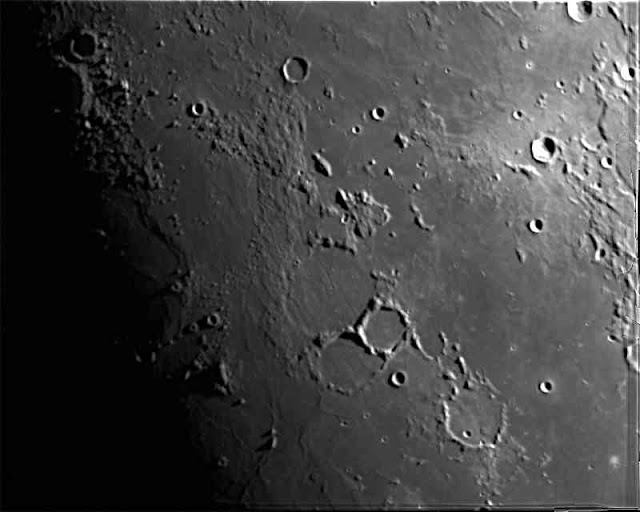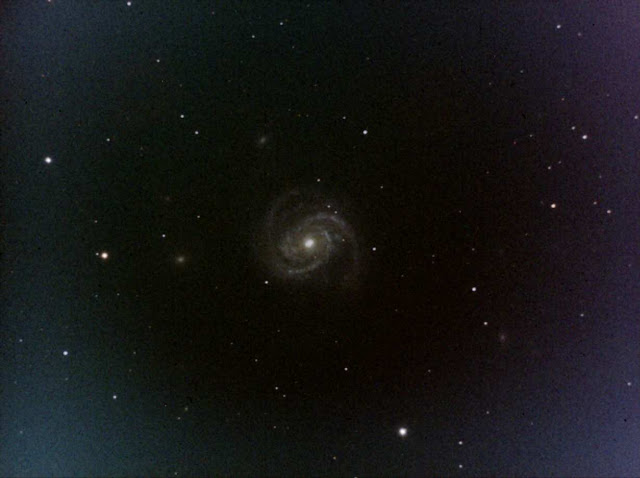A
Dog, A Dragonfly, An Experiment, and Variables
Lets
start with the dog; a Disney dog in this case. Specifically Pluto. If
it can't be a planet, I guess it can be a dog. One of my observing
goals has been to “see” all of the planets in our solar system.
The last one left would be, of course, Pluto. I know, I know; Pluto
isn't a planet any more. But it was when I started observing, so
Pluto it is. I can tell you up front, it's spectacularly
unimpressive.
 |
| Pluto, somewhere in there |
Above
is an image showing Pluto. It's that tiny dot of light inside the
white box. See what I mean? Spectacularly unimpressive. The hunt to
find it took quite a long time. But it was fun. Been there, done
that...Moving on....
The
remaining images in this entry are experiments. The next image of
NGC457, also know as the Dragonfly Cluster (or the Owl Cluster, or
the E. T. Cluster or the Kachina Doll Cluster, among others; take
your pick), was an attempt to overcome problems with light pollution
by taking a large number of exposures. The expectation was that it
would help to increase contrast, but wouldn't be a substitute for a
dark sky site. Pretty much, that seems to be the case. It also became
an unintentional segue into working on variable stars and problems
with at least one of those. More on that later.
 |
| NGC457 |
NGC457
is an open cluster in the constellation of Cassiopeia. It's about
7900 light years away and quite nice, I think. The two brightest
stars are often imagined as eyes and the rest of the stars (about 150
or so in the cluster) as “something”; E. T., a dragonfly, an Owl,
or whatever. Technically, the image is quite a challenge; most of the
stars in the cluster are quite dim, magnitude 12 to 15. The two
bright stars are magnitudes 5 and and 7. Why is this a challenge?
(Thank you for asking!) Well, the difference of one magnitude is a
difference of 2.51 in terms of brightness. That is to say, if there
is a difference of 1 magnitude between two stars, one of them is 2.51
times brighter than the other. So, if the dimmest star I captured
is, say 12th magnitude, the difference between the
brightest star (5th magnitude) and dimmest start (12th
magnitude) is 7 magnitudes. That means the brightest star is
2.51x2.51x2.51x2.51x2.51x2.51x2.51= 627 times brighter than the
dimmest star. That's a lot! That difference is referred to as dynamic
range. If you consider that the sky is actually the darkest element
of the image, the dynamic range is actually much greater than just
the difference in magnitudes of the stars. To capture the dimmer
stars, longer exposure times are required, which causes the brighter
stars to be overexposed or saturated. When that happens with CCD
cameras, the overexposed pixels “bleed over” into adjacent
pixels. Think of filling a glass with water, which gets overfilled
and spills over. The name given to this is “blooming”, and
cameras like mine have circuitry called anti-blooming circuitry to
help with this. As it turns out, I needed to retouch the image to
reduce the blooming that occurred around the bright stars. The
original image shows the blooming.
The
next experiment involves a different camera, one that's called a “one
shot color” camera. It's the one I use for lunar imaging, and is
essentially a color webcam. This one has the provision for internal
stacking (adding successive frames to make one still frame) to make a
long exposure. The target this time was another bright open cluster,
M11, also know as the Wild Duck Cluster.
 |
| M11 |
One
of the problems with using this camera is the inability to guide the
telescope automatically. All telescopes that track the sky do so with
some time of mechanical gearing. Because gears can't be made perfect,
they cause tracking errors that show up in the image as stars that
are not round, but elongated in one or two directions. To correct for
that as much as possible, some type of guiding is used. The easiest
type is another camera that sends the correcting signals
automatically. That's the method I usually use. So, images taken with
this camera will always have these guiding errors. That's usually not
too bad, because the exposures are usually very short, so little
movement is involved. However, it will show up in as little as 10
seconds with the image scale (or apparent magnification) used in this
image. What I was able to do was get 10 images, 9 of which were
usable, each 10 seconds long to make the single image you see above.
Bottom line, I might be able to use this method for bright star
clusters and get a color image quicker, but not with as much fine
detail, as using the “bigger” camera.
Finally,
one of the goals of the Starlight Observatory is to be able to
accurately record the brightness of the class of stars called
variable stars. As the name says, these stars change their brightness
over time, and observations of that variation helps to determine what
the cause of the variation is. One way to measure how bright a star
is would be to measure the number of electrons in the pixels that are
lit up by the variable star, and then do the same thing for a couple
of other stars in the same image that have known and documented
magnitudes. The process would work like this: 1) take an image
showing the variable (V) star, and the two other known stars, called
the check (K) and comparison (c) star. 2) the camera software
converts the number of electrons into a number between 0 and 65535.
3) Then, subtract the “software”, ie, 0 to 65535 value, of the
Check star from the Comparison star. 4) Subtract the “software”
value of the Comparison star from the Variable star. Mathematically,
K-C and V-C. To find the value of V, I just need to add the known
value of C to the value V-C and I've got the value for V. K-C serves
as a check to be sure all is ok. Example: Known values for K and C
are K=13.956, C=12.743, K-C= 1.213. Observed Value for V-C (ie, the
value derived from my image) = 1.791. The derived value for K-C =
1.052. For my data, I get the value, or magnitude of V as
1.791+12.743= 14.534. How close is that to the “real” value? One
measure is the K-C value. If it matched exactly, I could be pretty
sure. However, there is the difference, 1.213 vs 1.052 so confidence
is not perfect. There are explanations for the difference (variation
in the cloud cover, camera movement, inexact flatfielding, which is
really the most probable cause). But for now, just being sure I'm in
the right ball field is good enough. Well, the thing about most
variable stars is that they vary over fairly long time periods;
weeks, months, or years. There are, however, a few that vary over
much shorter time spans, like a few days. Algol is one such star. So,
on the night of October 16th, after checking the Sky and
Telescope Algol predictor app, I head out to the observatory to
record Alogl's variations. From my point of view, Algol (ra's
Al-ghul, in Arabic) lived up to it's namesake as the Demon (ghoul)
Star. Either the S & T app was incorrect, or my camera just
couldn't record the variation, but I got 2 hours of images similar to
the one below.
 |
| Algol, The Demon Star, Appropriate for October |
The
brightest star is Algol. And by my calculations, it never changed
brightness significantly. It should have decreased in brightness by
over a magnitude ( more than 2.5 times). It could have been my
camera; the shortest exposure it can take is 0.1 seconds. Even with
that short of an exposure, Algol is still out of the linear response
area of the camera (a bad thing for recording variable stars) and
very near saturation of the image (meaning overexposed). It was this
result that lead me to try using the webcam for star exposures. It
can make a much shorter exposure to prevent saturation. Problem is
that I would need to do more rigorous testing of the camera to
determine it's linear region. I'm not sure I'm ready for that.
Well,
that catches me up on all the images for today. As we go into the
winter months, we go from “globular season” to “open cluster
season” to “galaxy season” and back to “globular season next
year. Interesting, and some not so interesting nebulae thrown in for
good measure along the way. We'll see what the sky holds for next
time.


















































